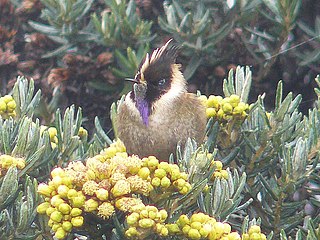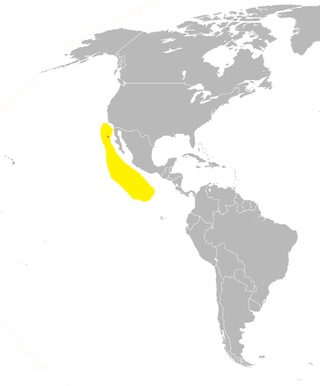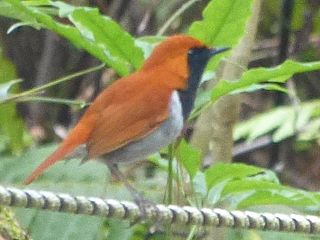
The Ryukyu robin is a bird endemic to the Ryūkyū Islands, of Japan. The Okinawa robin previously was considered a subspecies.

The Old World flycatchers are a large family, the Muscicapidae, of small passerine birds restricted to the Old World, with the exception of several vagrants and two species, bluethroat and northern wheatear, found also in North America. These are mainly small arboreal insectivores, many of which, as the name implies, take their prey on the wing. The family is relatively large and includes 351 species which are divided into 54 genera.

The Siberian blue robin is a small passerine bird that was formerly classified as a member of the thrush family, Turdidae, but is now more generally considered to belong to the Old World flycatcher family, Muscicapidae. It and similar small European species are often called chats. Recent research suggests that this species and some other East Asian members of Luscinia should be classified in a new genus, together with the Japanese and Ryūkyū robins. The genus name Larvivora comes from the Neo-Latin larva meaning caterpillar and -vorus meaning eating, and cyane is Latin for "dark-blue".

The Indian blue robin is a small bird found in the Indian Subcontinent. Formerly considered a thrush, it is now considered one of the Old World flycatchers in the family Muscicapidae. It was earlier also called the Indian blue chat. It is migratory, breeding in the forests along the Himalayas of Nepal, India, Myanmar and Bangladesh. They winter in the hill forests of the Western Ghats of India and in Sri Lanka.

The rufous-tailed robin is a small passerine bird. Its breeding range extends from southern Siberia and the Sea of Okhotsk to southern China and southeastern Asia.

Erithacus is a genus of passerine bird that contains a single extant species, the European robin. The Japanese robin and Ryukyu robin were also placed in this genus, but were moved to the genus Larvivora in 2006.

The Siberian grouse, also known as Siberian spruce grouse, Amur grouse, or Asian spruce grouse, is a short, rotund forest-dwelling grouse. A sedentary, non-migratory bird, it is the only member of the genus Falcipennis. The spruce grouse of North America, which physically looks similar, is now placed in the monotypic genus Canachites.

The blue-fronted fig parrot is a species of parrot in the family Psittaculidae. It is found in Salawati and the Bird's Head Peninsula in New Guinea. Its natural habitat is subtropical or tropical moist lowland forests.

The rufous-headed robin is a species of passerine bird in the family Muscicapidae. It is found in central China. Its natural habitats are temperate forests and temperate shrubland. This poorly known species is thought to be threatened by habitat loss.

The Ryukyu minivet is a species of bird in the family Campephagidae. It is endemic to Japan. The species was previously thought to be a subspecies of the ashy minivet. Its specific name is named for the Japanese naturalist Seiichi Tegima.

The white-browed bush robin is a species of bird in the family Muscicapidae. It is found from the Himalayas to south-central China and Taiwan. Its natural habitat is Rhododendron and conifer forests.

The Japanese leaf warbler is a leaf warbler. The species was first described by Robert Swinhoe in 1863. It was formerly included in the "Old World warbler" assemblage. It is closely related to the Arctic warbler and the Kamchatka leaf warbler, to which it was formerly considered conspecific.

The Herald petrel is a species of seabird and a member of the gadfly petrels. Its range includes the south Pacific Ocean and Indian Ocean.

The buffy helmetcrest is a Vulnerable species of hummingbird in the "coquettes", tribe Lesbiini of subfamily Lesbiinae. It is endemic to Colombia.

Larvivora is a genus of small passerine birds belonging to the Old World flycatcher family Muscicapidae that occur in central and eastern Asia.

Townsend's storm petrel is a species of seabird in the family Hydrobatidae. It breeds in the summer on rocks and islets of Guadalupe Island off the western coast of Mexico. It ranges in the Eastern Pacific Ocean north to southern California in the United States and south to 10°N latitude. It used to be considered a subspecies of the Leach's storm petrel. It was formerly defined in the genus Oceanodroma before that genus was synonymized with Hydrobates.

The Okinawa robin is a passerine bird endemic to Okinawa of Japan. It previously was considered a subspecies of the Ryukyu robin.

The Comoros blue vanga or Comoro blue vanga is a bird species in the family Vangidae. It is found in the Comoros, where its natural habitats are subtropical or tropical dry forest and subtropical or tropical moist lowland forest.
The Izu robin is a small passerine bird in the Old World flycatcher family Muscicapidae that is endemic to the Izu Islands of Japan.




















